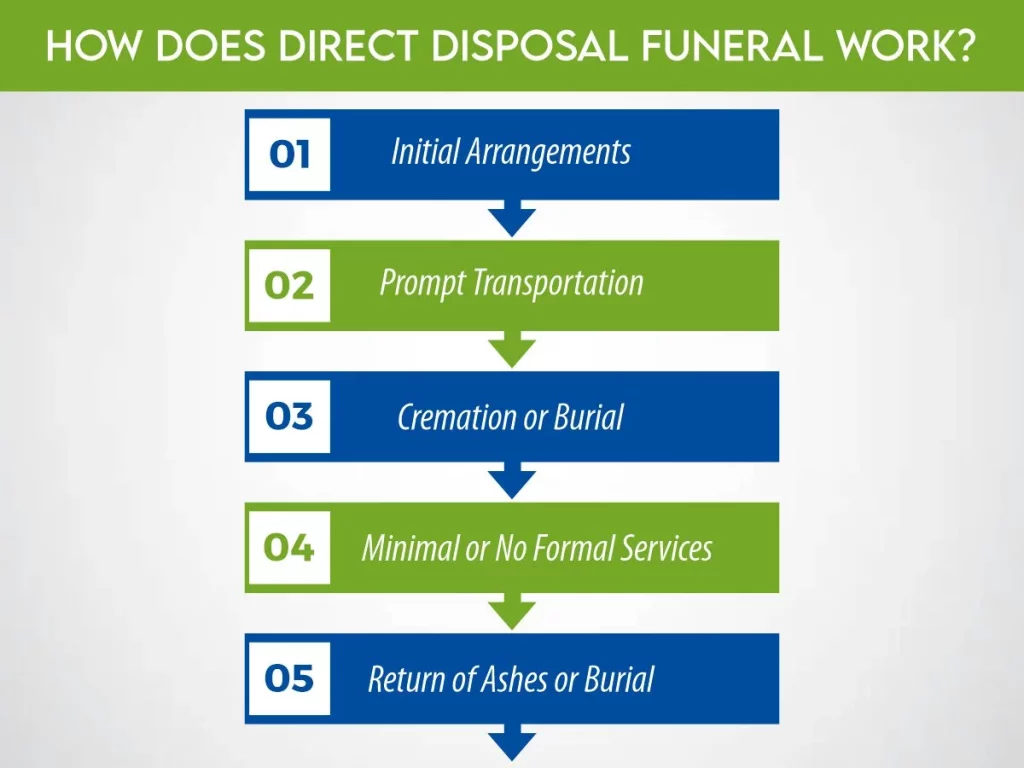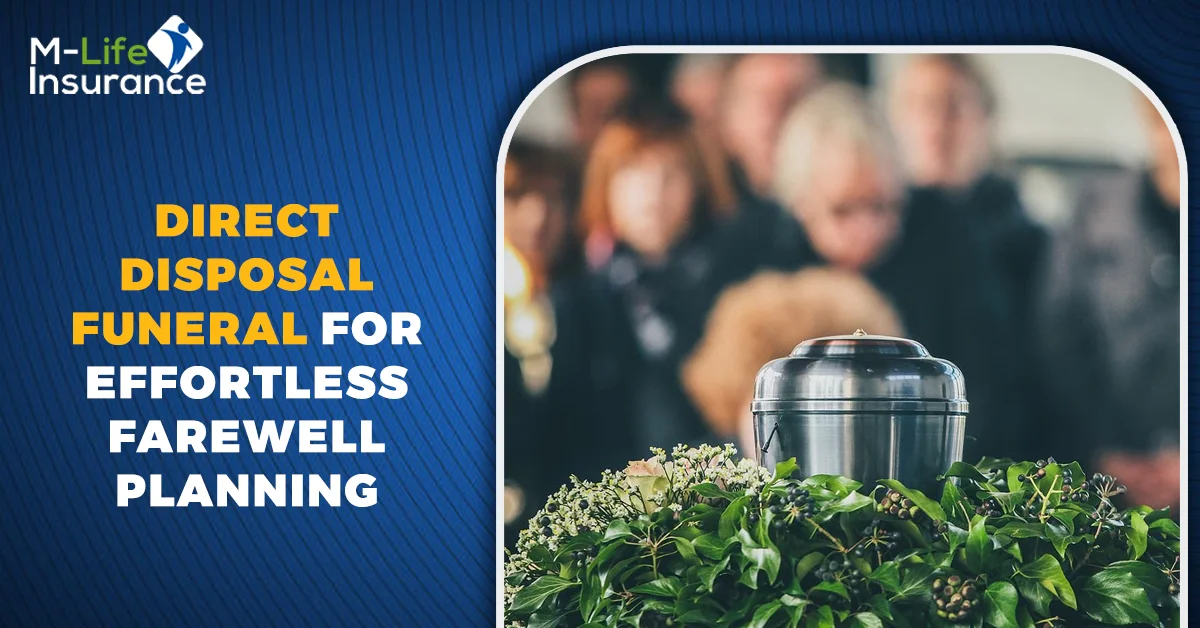Losing a loved one is never easy. Amidst the waves of grief, the thought of planning a farewell can feel like navigating a maze of choices and expenses. In such challenging times, finding a simpler, more affordable way to honor their memory becomes paramount. Enter the concept of direct disposal funerals—an alternative approach designed to streamline the farewell process without compromising on respect and remembrance.
Imagine a farewell that doesn’t involve the intricacies of traditional services but instead offers a straightforward path focused on simplicity and personalization. Direct disposal funerals pave the way for a dignified departure, allowing families to bypass the complexities of elaborate ceremonies and expenses.
In this guide, we unravel the essence of direct disposal funerals, exploring what sets them apart, what they include, and how they offer a meaningful, hassle-free path to bidding farewell to those we hold dear.
What is Direct Disposal Funeral?
A Direct Disposal Funeral, also known as direct cremation or direct burial, is a simplified and cost-effective alternative to traditional funeral services. Unlike conventional funerals that typically involve viewings, embalming, ceremonies, and elaborate caskets, a direct disposal funeral simplifies the process by focusing on the prompt disposition of the deceased.
In a direct disposal funeral, the body is swiftly transported to a crematorium or burial site without embalming or public viewing. This streamlined approach forgoes the traditional funeral rituals, allowing families to avoid the complexities and costs associated with them. Instead, the focus is on promptly and respectfully handling the final disposition of the deceased, usually without formal services or ceremonies.
The aim of a direct disposal funeral is to provide a straightforward and dignified way to say goodbye to a loved one, giving families the flexibility to honor the departed in their preferred manner at a later time or place.

How Does Direct Disposal Funeral Work?
A Direct Disposal Funeral operates on a simplified and efficient process compared to traditional funeral services. Here’s a breakdown of how it generally works:
1- Initial Arrangements
When a family chooses a direct disposal funeral, they work with a funeral home or service provider to make the necessary arrangements. These arrangements typically involve completing legal paperwork and securing required permits for the disposition.
2- Prompt Transportation
Once the legal formalities are in place, the deceased is promptly transported to a crematorium or burial site. This transportation is handled respectfully and efficiently, without involving embalming or public viewing of the deceased.
3- Cremation or Burial
At the chosen location (crematorium or burial site), the body is prepared for either cremation or burial, as per the family’s preference. If it’s a cremation, the body is placed in a cremation chamber. For burial, the body is placed in a casket and interred in the ground.
4- Minimal or No Formal Services
Direct disposal funerals usually skip formal services, allowing families the flexibility to arrange a memorial or celebration of life at a later time or place if desired. This absence of formal services contributes to the cost-effectiveness and simplicity of this approach.
5- Return of Ashes or Burial
In the case of cremation, the ashes (cremated remains) are returned to the family. These ashes can be placed in an urn, scattered, or used in various memorialization options. If it’s a burial, the body is interred in the chosen grave site.
The streamlined process of a direct disposal funeral prioritizes prompt and respectful disposition of the deceased while offering families flexibility in planning memorial services or ceremonies according to their wishes. This approach aims to simplify the farewell process, allowing families to focus on honoring their loved one’s memory in a way that feels most meaningful to them.
What is the Difference between Direct and Traditional Funeral Service?
The difference between a Direct Disposal Funeral and a Traditional Funeral Service lies in their approaches, rituals, and the overall experience they offer to families bidding farewell to a loved one:
- Simplicity vs. Elaboration
Direct Disposal Funeral: This type of service emphasizes simplicity. It promptly takes care of the disposition of the deceased without involving elaborate ceremonies, viewings, or embalming.
Traditional Funeral Service: Traditional services often include multiple events such as embalming, viewings, religious or secular ceremonies, and graveside services, spanning several days and involving various expenses.
Direct Disposal Funeral: It is generally more cost-effective as it skips many of the elements that contribute to the expenses of a traditional funeral, like elaborate caskets, embalming, and extended ceremonies.
Traditional Funeral Service: Traditional funerals tend to be more expensive due to the involvement of multiple services, casket options, venue rentals, and other associated costs.
- Timeframe and Flexibility
Direct Disposal Funeral: It proceeds swiftly, allowing families to promptly handle the disposition of the deceased and providing flexibility for families to arrange memorial services at a later time or place.
Traditional Funeral Service: These services often involve a longer timeframe, with various events spread out over several days, limiting flexibility in scheduling.
- Personalization and Ceremony
Direct Disposal Funeral: Typically, there are minimal or no formal services, offering families the freedom to customize memorials or ceremonies according to their preferences.
Traditional Funeral Service: These services often include specific rituals, religious or cultural ceremonies, and viewings that are important to many families for honoring their loved ones in a particular manner.
Do You Get Ashes from Direct Disposal Funerals?
Yes, in direct disposal funerals that involve cremation, the family typically receives the ashes, also referred to as cremated remains, after the cremation process is complete. These ashes are returned to the family in an urn or another container as per their preference.
Once the body is cremated, the remains are processed to reduce them to ashes. These ashes consist of bone fragments that are then finely ground to create a powder-like substance. The cremated remains are carefully collected and placed in an urn, allowing families to decide how they wish to handle them.
Families can choose various options for the ashes, including keeping the urn at home, scattering the ashes in a meaningful location, burying them in a cemetery or a memorial garden, or utilizing them in personalized memorialization items such as jewelry or artwork. This flexibility allows loved ones to honor the deceased in a way that holds special significance to them.
Services in Direct Disposal Funeral
Despite its simplicity, direct disposal funerals can still include certain services to aid the grieving process. They offer a comprehensive yet straightforward set of services aimed at respectfully handling the disposition of a loved one without the complexities of traditional ceremonies.
While specific offerings may vary among providers, a typical package often includes:
1- Basic Professional Services
This encompasses the essential guidance and expertise provided by the funeral home or service provider. It involves coordinating the necessary arrangements, completing legal documentation, and facilitating the prompt transportation and handling of the deceased.
2- Transportation of the Deceased
Swift and dignified transportation of the deceased to the chosen crematorium or burial site is part of the service. This ensures a seamless transition without public viewing or embalming, adhering to the family’s preferences.
3- Cremation or Burial Arrangements
The core component involves the preparation of the deceased for cremation or burial, aligned with the family’s choice. For cremation, this includes the use of a basic container, while for burial, it involves placing the body in a casket for interment.
4- Basic Container or Casket
Typically, a basic container or an inexpensive casket for the cremation or burial process is included. Families may opt for upgraded options beyond the standard offering at an additional cost.
5- Return of Ashes
In cases of cremation, the cremated remains (ashes) are collected and returned to the family in an urn or container of their choice, allowing for personalization or various memorialization options.
6- Documentation and Legal Permits
Assistance in completing necessary paperwork and securing legal permits required for the prompt disposition of the deceased is part of the service, ensuring compliance with regulations.
7- Guidance on Memorialization Options
While formal services are typically excluded, providers often offer guidance on various memorialization choices, enabling families to plan personalized tributes or ceremonies at a later time or location.
What is excluded in the Cost of Direct Disposal Funeral?
In a Direct Disposal Funeral, while the basic package covers essential services for the prompt disposition of the deceased, there are certain elements and services that might be excluded from the standard cost. These exclusions could include:
Memorial or Ceremony Expenses
Direct disposal funerals often do not include formal services, ceremonies, or viewings. Costs associated with arranging memorial services, religious ceremonies, or any specific rituals are typically not part of the basic package and might incur additional charges.
Urns or Containers
While a basic container or casket might be included for the disposition process, families often have the option to choose upgraded urns or containers for the cremated remains. Any customization or selection beyond the basic offering might involve extra expenses.
Transportation for Family Members
The cost of transportation for family members to the crematorium or burial site might not be included in the standard package. Families wishing to accompany the deceased or requiring specific transportation services might face additional charges.
Obituary Notices or Printed Materials
Expenses related to obituary notices in newspapers, online memorial pages, or printed materials such as memorial cards and programs are typically not covered in the basic package.
Floral Arrangements and Decorations
Costs for floral arrangements, decorations, or other ornamental elements for ceremonies or memorials are usually not included and will be an additional expense if desired.
Embalming or Extended Preservation
Direct disposal funerals bypass embalming. However, families requiring embalming or extended preservation services might face extra charges as these are not part of the standard direct disposal package.
It’s important for families considering a direct disposal funeral to discuss the specific offerings with the funeral home or service provider to understand the complete list of inclusions and exclusions, as additional services beyond the basic package could affect the overall cost.
Conclusion
Direct disposal funerals provide a practical and straightforward approach to bidding farewell to a loved one. Their simplicity, cost-effectiveness, and flexibility in memorialization options make them a viable choice for many families navigating the challenging terrain of grief. By understanding the differences between direct disposal and traditional funeral services, individuals can make informed decisions that suit their emotional needs and financial circumstances during this sensitive time.
In times of loss, opting for a direct disposal funeral allows families to focus on honoring their loved one’s memory without the added stress of elaborate ceremonies and costly arrangements. Ultimately, the essence of bidding farewell lies not in grandeur but in the heartfelt remembrance and celebration of a life well-lived.
